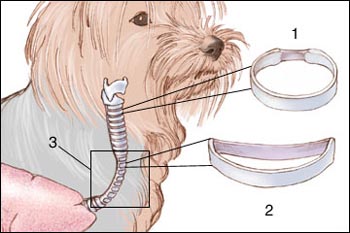 The collapse of your dog’s trachea or windpipe can be a serious health problem because the trachea is necessary for breathing. Unfortunately, this progressive disease is more common than you might think.
The collapse of your dog’s trachea or windpipe can be a serious health problem because the trachea is necessary for breathing. Unfortunately, this progressive disease is more common than you might think.
Tracheal collapse can be life threatening because the airway and the dog’s source of air will become obstructed. The collapse occurs when the rings that make up the windpipe begin to collapse. The usual symptom of tracheal collapse is a cough that sounds like honking.
What Causes Collapsed Trachea in Dogs?
The exact cause of trachea collapse in dogs is unknown, although veterinarians suspect that a congenital abnormality is responsible. The abnormality causes the cartilage of the tracheal rings weaker by limiting cell growth.
Tracheal collapse is more common in very small or toy breeds of dogs. The breed with the most reported cases is Yorkshire Terriers. Other breeds that are sometimes affected are Chihuahuas, Lhasa Apsos, Maltese, Pugs, Shih Tzus, Toy Poodles, and Pomeranians.
A collapsed trachea can occur at any age, but it is more common after age six to seven years. Overweight dogs are more likely to suffer from the problem.
What Are the Symptoms of a Collapsed Trachea in Dogs?
The first symptom of tracheal collapse that you will notice is a sudden spell of dry coughing. Many people say that this coughing will sound like a goose’s honk at first. The cough may start sounding more normal after a while.
Other symptoms of a collapsed trachea can include:
- Shortness of breath
- Difficulty swallowing food or water
- Less activity; the dog might stop running and not want to go on walks
- Trouble breathing
- Turning blue after exercise or when it becomes excited or stressed
- Collapsing for no apparent reason, and the dog could become paralyzed
If you see any of these symptoms, you should take the dog to the vet right away. Tracheal collapse is serious and can be life threatening if left untreated.
How Is Tracheal Collapse in Dogs Diagnosed?
You will have to go to the vet because only tests like X-rays, fluoroscopy, and endoscopy can be used to diagnose it. The veterinarian will need to x-ray the trachea to see if it is narrowing. She might also stick an endoscope, a device with a tiny camera on it, down the dog’s throat to see if there is an obstruction.
In some cases, the vet will also perform a cardiogram to see how well the dog’s heart is working. Samples of the dog’s blood and trachea may also be taken to see if an infection is present. The vet will look for a wide variety of causes, including tumors, polyps, infections, and an elongated soft palate.
How Is Collapsed Trachea in Dogs Treated?
Veterinarians have a wide variety of treatment options available for tracheal collapse.
1. Medications
The most common treatment is the use of drugs, including antibiotics, to clear up infections and corticosteroids to reduce inflammation. The vet might also use cough suppressants and bronchodilators to treat some of the symptoms. A 1994 study showed that 71% of the cases of tracheal collapse do respond to drugs.
2. Surgery
If the tracheal collapse is severe or does not respond to drugs, surgery may have to be performed. Several surgical techniques are used to treat collapse, including the insertion of polypropylene rings to replace the collapsed rings. Such surgery will usually have to be performed by a skilled surgeon rather than your regular vet because it is complex and tricky. There are also surgical techniques to relieve elongated palates and some related problems.
3. Weight Control
Owners can also relieve some of the symptoms of tracheal collapse by controlling the dog’s weight. Try to get the dog as close to its healthy weight as possible. Most veterinarians regard weight control as the best thing that owners can do for a dog with tracheal collapse. Keeping the dog’s weight low can help the canine avoid a collapsed trachea.
4. Opting for Chest Harness
Replacing the dog’s collar with a chest harness can also help the dog’s breathing. Chest harnesses are available at most shops and from many websites. Owners of breeds that are more susceptible to tracheal collapse should definitely use a chest harness at all times.
